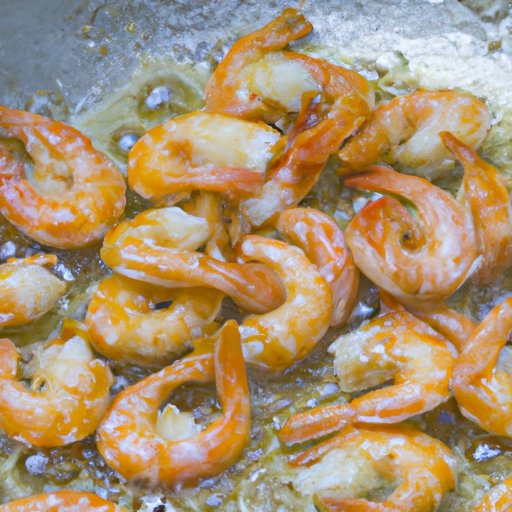I. Introduction
Frying shrimp is a delicious way to enjoy this versatile seafood. However, it can be tricky to get the perfect crispy texture without overcooking or under-seasoning. That’s why we’ve put together this step-by-step guide to help you fry shrimp like a pro.
In this article, we’ll cover secrets to making perfectly crispy shrimp, a step-by-step guide to frying shrimp, easy-to-prepare shrimp recipes, shrimp frying do’s and don’ts, and the health benefits and risks of frying shrimp. With these tips and tricks, you can create a satisfying and delicious shrimp dish that’s perfect for any occasion.
II. A Step-by-Step Guide to Frying Shrimp
Before you start frying shrimp, it’s important to select the best shrimp for the job. Look for shrimp that are fresh, firm, and have a mild odor. Avoid shrimp that smell strong or fishy, as they may be past their prime.
The next step is to prepare the batter. There are several types of batters you can use, including beer batter, tempura batter, and panko bread crumbs. It’s important to coat the shrimp properly to ensure that the batter adheres to the shrimp and creates a crispy exterior.
Once the batter is prepared, it’s time to fry. The key to perfectly fried shrimp is having the right temperature and timing. For best results, use a deep fryer or a heavy-bottomed pot with a thermometer to monitor the temperature. Fry the shrimp in batches to avoid overcrowding the pot and to ensure that each piece cooks evenly.
III. 5 Secrets to Making Perfectly Crispy Shrimp
Now that you know the basics of frying shrimp, let’s explore some secrets to making perfectly crispy shrimp.
First, choose the right oil for frying shrimp. High smoke point oils like peanut oil, canola oil, or vegetable oil work best. These oils can handle the high temperatures required for frying without burning or smoking.
Next, consider seasoning options for the batter. Different spices and herbs can add bold flavors to your shrimp. Common seasonings include garlic powder, onion powder, cayenne pepper, paprika, and basil.
Incorporating cornstarch or bread crumbs can also help achieve the perfect crispiness. Cornstarch helps create a light, airy batter, while bread crumbs add a crunchy texture.
Cooking time and temperature also play a role in creating perfectly crispy shrimp. Make sure the oil is hot enough before adding the shrimp, and avoid overcooking to prevent tough, rubbery shrimp.
IV. A Collection of Easy-to-Prepare Shrimp Recipes
Now that you know how to fry shrimp and make them crispy, it’s time to try out some easy-to-prepare shrimp recipes. Below are three recipes with different levels of difficulty:
Cajun Fried Shrimp
For Cajun Fried Shrimp, season the shrimp with cajun seasoning and coat in a mixture of flour, cornmeal, and spices. Fry in hot oil until golden brown and crispy.
Coconut Shrimp
For Coconut Shrimp, dip the shrimp in an egg wash and then in a mixture of coconut flakes, flour, and spices. Fry until golden brown and crispy. Serve with a sweet chili sauce for dipping.
Garlic Shrimp
For Garlic Shrimp, sauté the shrimp in garlic and butter until cooked through. Serve hot with a squeeze of lemon and garnish with parsley.
Each recipe works well with a variety of batters and seasoning options. Feel free to experiment and find your favorite flavor combinations.
V. Shrimp Frying Do’s and Don’ts
When frying shrimp, there are some common mistakes to avoid. Overcooking and under-seasoning are two of the biggest pitfalls. It’s also important to handle the shrimp properly to avoid cross-contamination and food-borne illness.
Some do’s and don’ts to keep in mind when frying shrimp include:
- Do use fresh shrimp with a mild odor and firm texture.
- Do coat the shrimp in batter and seasoning evenly.
- Do use a thermometer to monitor oil temperature.
- Don’t overcook the shrimp, as it can become tough and rubbery.
- Don’t overcrowd the pot when frying shrimp.
- Don’t cross-contaminate raw and cooked shrimp.
VI. Frying Shrimp: Health Benefits and Risks
While fried shrimp may be tasty, it’s important to consider the health risks and benefits associated with this cooking method.
Shrimp are a great source of lean protein and low in calories. They’re also high in vitamins and minerals like B12, iron, and selenium.
However, frying shrimp can add extra calories and fat to this otherwise healthy food. The oil used for frying can also contain unhealthy trans fats, which can increase the risk of heart disease and high blood pressure.
To minimize these risks, consider using healthier oils like olive or avocado oil instead of traditional vegetable oil. Moderation is also key, so don’t indulge in fried shrimp too often.
VII. Conclusion
Now that you know how to fry shrimp like a pro, there’s no limit to the delicious dishes you can create. From classic fried shrimp to flavorful variations like Cajun and coconut, there’s a shrimp recipe for every taste.
Remember to choose fresh shrimp, prepare the batter properly, and fry at the right temperature and timing for perfect results. With these tips and tricks, you’re well on your way to creating a satisfying and tasty shrimp dish.
